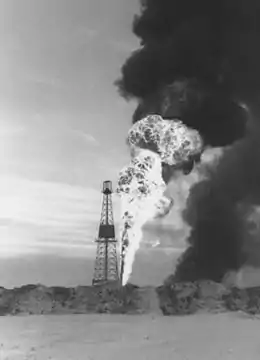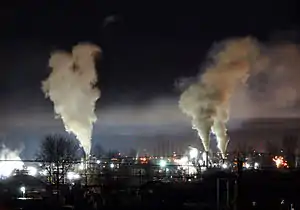Environmental issues in Canada
There are many different types of environmental issues in Canada which include air and water pollution, climate change, mining and logging. Environmental issues based in Canada are discussed in further detail below.
Climate change


Climate change in Canada has had large impacts on the country's environment and landscapes. These events are likely to become even more frequent and severe in the future due to the continued release of greenhouse gases into the atmosphere. The number of climate change–related events, such as the 2021 British Columbia Floods and an increasing number of forest fires, has become an increasing concern over time.[1] Canada's annual average temperature over land has warmed by 1.7 degrees Celsius since 1948. The rate of warming is even higher in Canada's north, the Prairies, and northern British Columbia. The country's precipitation has increased in recent years and extreme weather events have become more common.
Canada is currently the world's 10th largest greenhouse gas emitter,[2] and has a long history of producing industrial emissions going back to the late 19th century. In 2019 transport and oil and gas extraction together emitted over half of the total.[3] Canada's fossil fuel extraction industry has increased its greenhouse gas emissions by 21.6% since 1990.
Canada is committed to reducing its greenhouse gas (GHG) emissions by 30% below 2005 levels by 2030 under the Paris Agreement. In July 2021, Canada enhanced the Paris Agreement plans with a new goal of reducing emissions by 40–45% below 2005 levels by 2030.[4] Several climate change mitigation policies have been implemented in the country, such as carbon pricing, emissions trading and climate change funding programs. In 2019, the House of Commons voted to declare a national climate emergency in Canada.Melting of the Arctic and its effects on marine ecosystems
Scientists across the world have already started to notice massive reductions in Canada's Arctic sea ice cover, particularly during the summertime. The shrinking of this ice results in the disruption of the ocean circulation, and changes in climate and weather around the world.[5]
[6] The 2019 Canada's Changing Climate Report, written by scientists from institutions around the globe, states that the impacts of climate change on Atlantic Canada will be very diverse. One impact is that the sea ice will become thinner and will also form for much shorter periods of the year. And with less sea ice than the region usually gets now, wave seasons will become more intense. Atlantic Canada will see a relative rise in sea levels everywhere - a rise which is estimated to be 75 to 100 cm by the year 2100. Scientists also predict that even if emissions decrease, a 20-cm rise is expected to take place during the course of the next 20 to 30 years.[7] As the ocean warms and subtropical waters move north, the ocean will become warmer and saltier, and since warmer water holds less oxygen than cooler water, marine ecosystems can suffer and become less sustainable because of this lower oxygen level.[8] In the journal, Science, which was published in March 2019, it explains that warmer waters could actually increase fish stocks in certain regions, like the halibut found off the coast of Newfoundland and Greenland but other species such as the Atlantic Cod and albacore tuna might not be able to cope with the conditions so well.
Conservation

The Rainforest Action Network and indigenous groups have campaigned to protect the boreal forest of Canada from logging and mining. In July 2008 the Ontario government announced plans to protect some of the area from all industrial activity.[9][10]
Logging
Logging of old growth forest continues in Canada. The Ancient Forest Alliance is an environmental group in British Columbia, dedicated to stopping logging in endangered old growth forests, and ensuring the sustainable logging of second growth forests.[11]
The forests of Clayoquot Sound are still being logged. There are ongoing protests over the logging and in 1993 it was the site of the largest act of peaceful civil disobedience in Canada.[12]
Pollution

Air pollution

Air pollution is the release of pollutants (a substance or energy introduced into the environment that has undesired effects) into the air that are detrimental to human health and the Earth.[13] In Canada, air pollution is regulated by standards set by the Canadian Council of Ministers of the Environment (CCME), an inter-governmental body of federal, provincial and territorial Ministers responsible for the environment. Air pollution from the United States and to lesser extent Canada; caused by metal smelting, coal-burning for utilities, and vehicle emissions has resulted in acid rain, has severely impacted Canadian waterways, forest growth, and agricultural productivity.[14]
Pollution reduces the value of the assets that make up Canadians’ wealth. Properties are less valuable when they are polluted. It is estimated that pollution costs Canada tens of billions of dollars every year. [15] Transportation is one of the main sources of air pollution and greenhouse gas emissions in Canada and are responsible for more than a quarter of all greenhouse gases and air pollutants in Canada. Pollutants' concentrations in the air can be influenced by many factors, such as the number of air pollutants, proximity to sources, and weather conditions. Canada’s population and economy growth increases the demand for the production and supply of services, transportation and housing. The energy required to meet such demands comes partially from fossil fuels, which affects air quality. The growing demand for Canadian exports, such as the oil and gas industry, also generates the release of air pollutants. [16]Chemical pollution
The Aamjiwnaang First Nation community has expressed concern regarding its proximity to chemical plants, as birth rates of their people have been documented by the American journal Environmental Health Perspectives as deviating from the normal ratio of close to 50% boys, 50% girls.[17] The ratio as found between 1999 and 2003 by the journal was roughly 33% boys, and 67% girls.[18] The First Nation is concerned that this abnormal trend is due to adverse effects of maternal and fetal exposure to the effluent and emissions of the nearby chemical plants. This is the first community in the world to have a birth rate of two girls to every boy.[19]
Mining pollution
Canada, like most other countries with significant
Plastic pollution
In the year 2022 Canada announced a ban on producing and importing single use plastic from December 2022. The sale of those items will be banned from December 2023 and the export from 2025. The prime minister of Canada Justin Trudeau pledged to ban single use plastic in 2019. As for now in Canada "Up to 15 billion plastic checkout bags are used each year and approximately 16 million straws are used every day" [20]
See also
References
- Rosano, Michela (July 26, 2018). "Photos: How climate change is transforming Canada". Canadian Geographic. Archived from the original on November 28, 2020. Retrieved April 18, 2021.
- "| Greenhouse Gas (GHG) Emissions | Climate Watch". www.climatewatchdata.org. Archived from the original on March 21, 2022. Retrieved 29 March 2022.
- "Greenhouse gas emissions". www.canada.ca. January 9, 2007. Archived from the original on October 19, 2017. Retrieved 2021-07-03.
- Canada, Environment and Climate Change (2021-07-12). "Government of Canada confirms ambitious new greenhouse gas emissions reduction target". www.canada.ca. Archived from the original on April 26, 2022. Retrieved 2022-04-26.
- "Home". climaterealityproject.org.
- "Anti-logging protest becomes Canada's biggest ever act of civil disobedience". the Guardian. 2021-09-08. Retrieved 2022-06-17.
- https://globalnews-ca.cdn.ampproject.org/v/s/globalnews.ca/news/5918981/climate-change-impact-across-canada/
- "Canada's fish stocks plummeting — Ottawa needs a 'wake up call' to save it: Report - National | Globalnews.ca".
- Zabarenko, Deborah (2008-11-09). "Politicians persuaded to save Canada boreal forest". Reuters. Archived from the original on 2018-11-11. Retrieved 2018-11-11.
- "Huge News for Ontario's Boreal Forest and its peoples. - The Understory - Rainforest Action Network". Rainforest Action Network. Archived from the original on 2018-11-11. Retrieved 2018-11-11.
- "Anti-logging protest becomes Canada's biggest ever act of civil disobedience". the Guardian. 2021-09-08. Retrieved 2022-06-17.
- "Anti-logging protest becomes Canada's biggest ever act of civil disobedience". the Guardian. 2021-09-08. Retrieved 2022-06-17.
- Mackenzie J (November 2016). "Air Pollution: Everything You Need to Know". NRDC. Retrieved 2021-02-25.
- Boyd DR (2011). Unnatural Law: Rethinking Canadian Environmental Law and Policy. UBC Press. pp. 67–69. ISBN 978-0-7748-4063-7.
- "Costs of Pollution in Canada". www.iisd.org. Retrieved 2021-04-08.
- "Canada Air Quality Index (AQI) and Air Pollution information | AirVisual". www.iqair.com. Retrieved 2021-04-08.
- C. A. Mackenzie; A. Lockridge; M. Keith (2005). "Declining Sex Ratio in a First Nation Community". Environmental Health Perspectives. 113 (10): 1295–1298. doi:10.1289/ehp.8479. PMC 1281269. PMID 16203237.
- "Aamjiwnaang First Nations concerned about chemical exposure". CBC News. 2005-09-02. Retrieved 2008-10-21.
- Mittelstaedt, Martin (2004-07-31). "Where the boys aren't". The Globe and Mail. Archived from the original on 2018-11-11. Retrieved 2018-11-11.
- Newburger, Emma (21 June 2022). "Canada is banning single-use plastics, including grocery bags and straws". CNBC. Retrieved 4 July 2022.